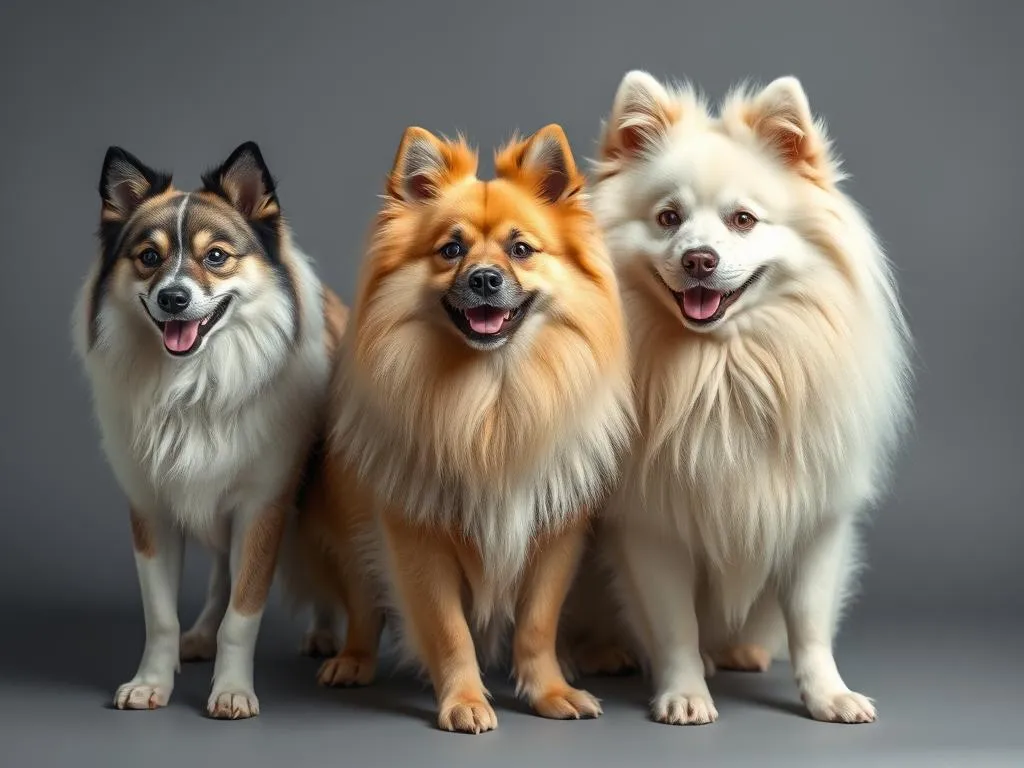
Introduction
Spitz dog breeds are a fascinating group of canines known for their distinct physical characteristics and charming personalities. Defined by their thick double coats, pointed ears, and bushy tails, these dogs have captured the hearts of dog enthusiasts worldwide. Understanding the different types of Spitz breeds is crucial for potential dog owners, as each breed comes with its own set of traits, care requirements, and temperaments.
In this article, we will delve into the characteristics that define Spitz breeds, explore popular types of Spitz dog breeds, and discuss their training, grooming, and care needs. By the end of this read, you will have a comprehensive understanding of what it means to welcome a Spitz breed into your home.
Characteristics of Spitz Dog Breeds
Physical Traits
Spitz breeds are easily recognizable due to their unique physical features. The most notable characteristics include:
-
Coat Types and Colors: Most Spitz breeds have a thick double coat that provides insulation against harsh climates. The outer coat is often coarse and straight, while the inner coat is soft and dense. Coat colors can vary widely, including shades of white, black, gray, brown, and even combinations of these colors.
-
Ear Shapes and Tails: A hallmark of Spitz breeds is their erect ears, which contribute to their alert demeanor. Additionally, many of these breeds have curled tails that rest over their backs, adding to their distinctive silhouette.
-
Size Variations: Spitz breeds come in various sizes, from the small Pomeranian to the larger Alaskan Malamute. This diversity allows potential dog owners to choose a breed that fits their living situation and lifestyle.
Temperament
The temperament of Spitz breeds is generally characterized by their loyalty and alertness. Here are some common personality traits:
-
Loyalty: Spitz breeds tend to form strong bonds with their families, often exhibiting protective behaviors towards those they love.
-
Alertness: With their keen senses, these dogs are naturally alert and make excellent watchdogs. They are quick to notice changes in their environment and will often bark to alert their owners.
-
Playfulness: Many Spitz breeds are playful and energetic, requiring regular physical activity and mental stimulation to keep them happy.
Health Considerations
Like all dog breeds, Spitz breeds can be prone to certain health issues. Some common health concerns include:
-
Hip Dysplasia: This hereditary condition can affect larger Spitz breeds, leading to joint problems and discomfort.
-
Skin Allergies: Due to their dense coats, some Spitz breeds may be susceptible to skin allergies, requiring special care.
-
Lifespan and Care Requirements: Most Spitz breeds have a lifespan ranging from 12 to 15 years, but this can vary based on genetics and care. Regular veterinary check-ups, a balanced diet, and proper exercise are essential for maintaining their health.
Popular Types of Spitz Dog Breeds
Nordic Spitz Breeds
Nordic Spitz breeds are known for their resilience in cold climates and their strong working instincts. Originating from northern regions, these breeds often have a history of herding, sled pulling, and hunting.
-
Alaskan Malamute: This large breed is known for its strength and endurance. Originally bred for heavy hauling in Arctic conditions, they are friendly and loyal but require plenty of exercise.
-
Siberian Husky: Famous for their striking blue or multicolored eyes, Siberian Huskies are energetic and intelligent. They were bred for sledding and are known for their friendly disposition and love of companionship.
German Spitz Breeds
Germany boasts a variety of Spitz breeds, each with its unique history and traits.
-
German Spitz (Standard, Mittel, and Klein): These breeds come in different sizes, from large to small, and share a similar appearance. They are known for their playful nature and make excellent family pets.
-
Pomeranian: Perhaps the most recognized of the German Spitz breeds, Pomeranians are small, fluffy dogs with a big personality. They are intelligent and often require consistent training to manage their spirited nature.
Japanese Spitz Breeds
Japanese Spitz breeds are cherished for their beautiful appearance and friendly nature.
-
Japanese Spitz: This breed resembles the American Eskimo dog and is known for its fluffy white coat and cheerful disposition. They are loyal companions and thrive in family environments.
-
Shiba Inu: While slightly different in appearance, the Shiba Inu is a popular breed in Japan. Known for their fox-like features and spirited personality, Shiba Inus are independent and can be aloof with strangers.
American Spitz Breeds
American Spitz breeds encompass a range of dogs developed in the United States, often drawing inspiration from their European counterparts.
-
American Eskimo Dog: This breed comes in three sizes (toy, miniature, and standard) and is known for its intelligence and agility. They are friendly, energetic, and protective of their families.
-
Kishu Ken: Originally bred for hunting, the Kishu Ken is a medium-sized dog that is loyal, reserved, and independent. They are less common but known for their strong hunting instincts.
Training and Socialization of Spitz Breeds
Importance of Early Training
Early training and socialization are crucial for all Spitz breeds. These dogs are intelligent but can also be stubborn, so a consistent training approach is essential.
-
Techniques for Effective Training: Positive reinforcement methods, such as treats and praise, work best with Spitz breeds. Engaging them in obedience classes can also help establish a solid foundation.
-
Socialization with Other Pets and People: Introducing your Spitz breed to various environments, people, and other animals from a young age will help them develop into well-rounded adults.
Common Behavioral Issues
Spitz breeds can exhibit specific behavioral challenges that require attention.
-
Stubbornness: Some Spitz breeds may be headstrong, making it essential to establish leadership and consistency in training.
-
Barking: Many Spitz breeds are known for their vocal nature. Training them when to bark and when to be quiet is crucial to minimize excessive barking.
-
Solutions and Tips: Incorporating training games, providing mental stimulation, and ensuring adequate exercise can help manage behavioral issues.
Grooming and Care for Spitz Breeds
Grooming Needs
Grooming is an essential part of caring for Spitz breeds, given their thick double coats.
-
Coat Maintenance: Regular brushing is necessary to prevent matting and reduce shedding. Depending on the breed, bathing may be required every few weeks to keep their coat clean.
-
Nail Trimming and Ear Cleaning: Regular nail trimming is essential to prevent discomfort and injury. Cleaning their ears helps prevent infections, especially in breeds with fluffy fur around the ears.
Diet and Nutrition
Feeding your Spitz breed a balanced diet is crucial for their overall health.
-
Recommended Diets: High-quality dog food, rich in protein and essential nutrients, is recommended. It’s essential to choose a diet appropriate for their age, size, and activity level.
-
Common Dietary Issues: Some Spitz breeds may be prone to obesity if their diet is not monitored. Regular exercise and portion control are key to maintaining a healthy weight.
Exercise Requirements
Spitz breeds are known for their energy levels and require regular exercise.
-
Overview of Activity Levels: While the energy levels can vary by breed, most Spitz breeds need at least 30 minutes to an hour of exercise daily.
-
Suggested Exercise Routines: Activities like walks, playtime in the yard, and interactive games like fetch can help keep your Spitz engaged and healthy.
Choosing the Right Spitz Breed for You
Factors to Consider
When selecting a Spitz breed, consider your lifestyle and living situation.
-
Lifestyle Compatibility: Assess whether you lead an active or more sedentary lifestyle. Some breeds require more exercise and mental stimulation than others.
-
Space Requirements: Larger breeds may need more space, while smaller ones can adapt well to apartment living. Ensure your home environment suits the breed you choose.
Adoption vs. Buying from Breeders
Deciding between adopting a dog or purchasing from a breeder is an important consideration.
- Pros and Cons of Each Option: Adoption can provide a loving home for a dog in need, while purchasing from a breeder allows you to choose specific traits. Weigh the benefits and responsibilities of each option before making a decision.
Questions to Ask Breeders or Shelters
When meeting with breeders or shelters, it’s essential to ask the right questions to ensure you’re making an informed decision.
- Essential Questions: Inquire about the dog’s health history, temperament, socialization practices, and any genetic testing done. Understanding the dog’s background can help you prepare for their arrival.
Conclusion
Understanding the various types of Spitz dog breeds is vital for choosing the right companion for your home and lifestyle. Each breed offers unique traits and characteristics, making it essential to research thoroughly before making a decision. With responsible ownership, training, and care, a Spitz breed can become a cherished member of your family, bringing joy and companionship for many years.





